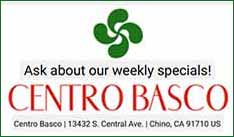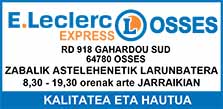Paul Richardson. Until a few months ago, I’d never even heard of Goierri. The name of this county on the eastern edge of the Gipuzkoa province means “highlands” in the Basque language. Staunchly rural in character, yet (somewhat paradoxically) underpinned by heavy industry, the county enjoys low unemployment and, thus far, has had little engagement with tourism. The Basque separatist presence in the area has also tended to scare off prospective visitors. But, since 2011, when the separatist group Eta called a “permanent” truce, things have begun to change. Last year, in a bid to raise its profile, the Goierri tourist board created a six-day walking trail based on the area’s most celebrated food product, the raw-milk sheep’s cheese Idiazábal.
During the sultry final days of the summer I took a three-day hike along the new “Idiazábal Gaztaren Ibilbidea” (Idiazábal cheese route), skipping some of its stages but making sure to take in highlights such as the beechwoods of Lizarrusti, the Túnel de San Adrián — a cavelike pass, declared a Unesco world heritage site in July this year — and the mountains of Aizkorri, where, following a millennial tradition, great flocks of shaggy-haired latxa sheep and their shepherd masters spend part of the year among the rich pastures of Urbia.
The complete route covers just short of 100km, in a circle that weaves among mountain scenery and medieval townscapes and provides a window on to the culture of Idiazábal cheese in its various aspects, from shepherding life and lore to the making of the cheese itself and its privileged place in Basque gastronomy. Accommodation is in simple inns, even simpler mountain refuges, and homely farmhouse “agroturismos”, including a working cheese-dairy and a cider-maker — all to be found within a few steps of the path.
. . .
I decide to begin with the “urban”section of the route’s six stages, setting out from Ordizia, where a bustling food market is in full swing in a handsome columned marketplace (the market has happened here every Wednesday since Queen Juana “The Mad” granted permission for it in 1512).
[Spain map]
A string of small towns lies along the valley. In Idiazábal, I pay homage at the monument to the Basque shepherd and, at the museum, receive a complimentary T-shirt, route map, cheese and bottle of cider. Next comes Beasain, which seems unremarkable until I come upon the town’s pristine nucleus, a rus in urbe hamlet composed of a watermill, a stone toll bridge, a grand house where kings once slept, and a farmhouse with an old cider press. The farmhouse has now been transformed into a sleek hotel, the Dolarea, where chef Iban Mate offers me a tasting of Idiazábal cheese paired with the white wine txakoli.
Outside the pretty town of Segura — Basque to its medieval core — I stop for the night at a farmhouse where shepherd Felix Goiburu and his family make an artisan Idiazábal with the raw milk of their 115 latxa sheep. Ondarre is an imposing three-floored house dating from the 16th century, standing beside a stream. From my room, as the sun sets, the massif of Aizkorri looms on the horizon, its crags of ashen-white karst gleaming above a swath of woodland.
Down in the tasting room, Felix and his wife Karmele tell me proudly that their cheese won “best in show” last year at the annual September fair in Ordizia, with a single cheese selling at the charity auction for €13,050. The family’s four-month-old Idiazábal is indeed stunningly good, and their smoked version, hauntingly flavoured with the smoke of alder wood, in a different league from the orange-coloured, artificial-tasting smoked cheeses I remember from my childhood. Eneko, the young man poised to take Ondarre into its sixth generation, poses for my camera beside a framed photograph of his grandfather wearing a beret and wielding a shepherd’s stick. The resemblance is striking: both have the same strong-boned Basque features, the same high forehead and genial, confident smile.
. . .
[Cheese for sale at the town’s medieval fair] ©Alamy
Cheese for sale at the town’s medieval fair
Further west along the route, I can’t quite believe the idyll that is Zerain, a village of 200 souls snoozing in a dream of rural quietude. After a visit to the village ethnographic museum — a chance to muse on the forgotten byways of local life — I pass Oiharte, a traditional cider-house, where I note with approval the classic cider-house menu of salt-cod omelette followed by a slab of chargrilled ox steak. There’s a pleasant agroturismo attached to Oiharte, and it’s tempting to check in for my second night on the road. But I have, as the Robert Frost poem puts it, miles to go before I sleep. I have spartan lodgings booked in the mountain refuge in Lizarrusti, where tomorrow I’ve arranged for a local guide, José Ramón Aguirre, to show me Bronze Age dolmens, tumuli and menhirs in the natural park of Aralar — the largest of the Goierri’s great protected spaces.
This morning, however, my objective is Aizkorri, whose high tableland I aim to reach via the Túnel de San Adrián. A gaping hole in the face of the mountain, the pass was for centuries a major access route for travellers between Spain and northern Europe. The Túnel is a rich seam of anecdote and legend. Kings, armies, bandits and pilgrims have all passed along it. It’s even said that Charles V came through on his way from Flanders to take up the Spanish throne. As I stand in the cave’s dark mouth, where cows lean against the walls of a rustic chapel, I try to imagine the emperor, perhaps in a velvet-lined carriage, passing by with all his retinue.
Beyond the Túnel lies a medieval stone pathway where the Idiazábal route coincides with the Way of Saint James. The path now leads through deep, dark woods of beech and holly, then up a sudden hillside where the path opens up into a wide plain, gently sloping at its edges and crowned by bleached crags: the valley of Urbia, at the heart of the Aizkorri-Aratz natural park.
. . .
Here, in their small but perfectly comfortable shepherds’ hut, I meet the Aranburu brothers. José, Javier and Juan José run their cheesemaking operation at a state of the art dairy outside Idiazábal, but the roots of the business, and of the family itself, lie deep in the rural traditions of the Goierri. While Javier and José take charge of the dairy, “Juanjo” gave up his factory job to spend his summers in Urbia with his wife Angeles and the family’s 1,200-strong herd of latxas.
[A flock of laxta sheep in Idiazábal] ©Alamy
A flock of laxta sheep in Idiazábal
A generously built man in blue work-trousers, Juanjo welcomes me on the threshold of his chabola, a small stone structure which the local government has kitted out with solar panels and a water heater. At the height of summer the valley is inhabited by a dozen shepherds and 10,000 sheep. Strictly off-limits to motor vehicles apart from the shepherds’ four-wheel drives, the valley has few creature comforts — we’re talking plain living and no phone signal — apart from a simple bar-restaurant, the Urbiako Fonda, where Juanjo and his colleagues meet up to pass long summer evenings over the occasional modest serving of beer.
“Our sheep are over there,” says Juanjo, waving his slender staff energetically. If I screw up my eyes in the sunlight I can just make them out, spots of white like maggots on a distant hillside.
Taking in the huge view, I’m struck by how green the valley is — and how remote it seems from urban civilisation, despite being just 58 miles from San Sebastián, 48 from Pamplona. We repair to the hut, where Angeles dishes up plates of tomato salad and fried fillet of beef. To drink, there is Oiharte cider; for dessert there is Idiazábal cheese: the Aranburus’ own. The little house is neon-lit and bare-walled but there’s something deeply appealing about these people’s off-grid, low-stress lifestyle. The remarkable survival of an archaic way of life, albeit in a palliated 21st-century form, is another of the lessons of the Idiazábal route.
“At the factory, I was a slave to my watch. Up at Urbia, no one can tell me what to do,” declares Juanjo Aranburu.
“Nobody bothers us here!” agrees his apple-cheeked wife, beaming as she opens another bottle of cider.



 Send to a friend
Send to a friend Add comment
Add comment








